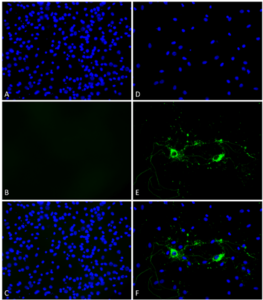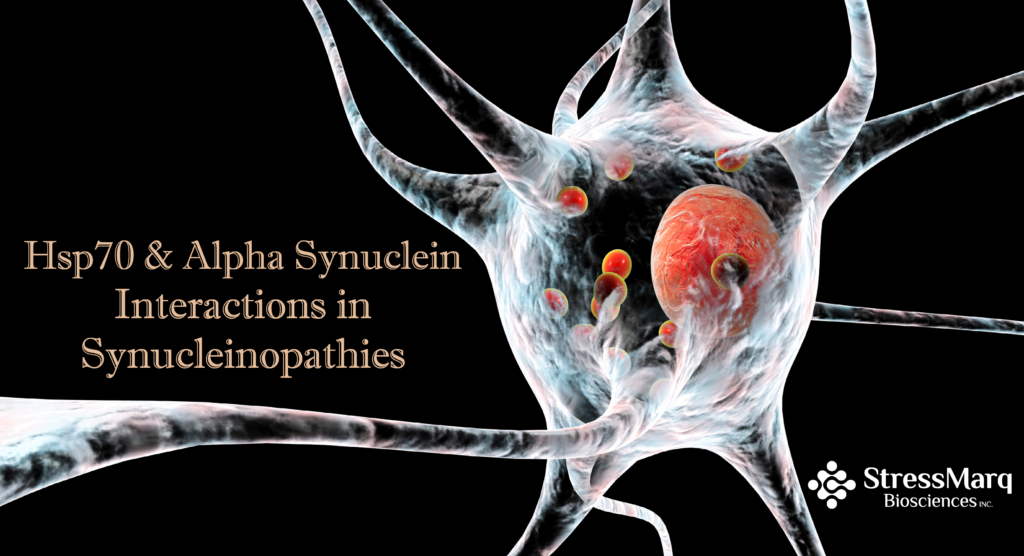Hsp70 and Alpha Synuclein Interaction in Synucleinopathies
Lewy body disorders such as Parkinson’s disease (PD) and Lewy body dementia (LBD) are more prevalent in older individuals of the male sex. They are characterized by the progressive deposition of insoluble inclusions (Lewy bodies and Lewy neurites) in the brain, of which α-synuclein is a major component. Heat shock protein 70 (Hsp70), a molecular chaperone that is released into extracellular compartments in response to cellular stress, is also found within these inclusions, suggesting its possible entrapment and cytosolic depletion. To better understand the sex-skewed emergence of Lewy-related pathology, a team of researchers led by Tarun N. Bhatia, Ph.D., of Duquesne University, Pittsburgh, investigated how males and females differ in their dependence on Hsp70 during the development of α-synucleinopathy. Their data, published in Neurotherapeutics, include immunocytochemical analysis of rat primary neuron cultures for pathologically phosphorylated α-synuclein (pSer129) inclusions following treatment with StressMarq’s Mouse Alpha Synuclein Pre-formed Fibrils.
Hsp70 inhibition worsens α-synucleinopathy more robustly in male neurons
To establish a primary neural cell culture model, Bhatia et al. isolated hippocampal cells from Sprague Dawley rat brains for α-synuclein pre-formed fibril (PFF) studies. Following treatment with 1 or 4 µg/mL sonicated Mouse Alpha Synuclein Pre-formed Fibrils one day after cell harvest (termed day in vitro 2, or DIV2), mixed sex cultures were assayed at time points spanning 6 hours to 16 days for the number of pSer129+ α-synuclein inclusions present (measured via immunocytochemistry and expressed as a fraction of Hoechst+ cells or NeuN+ neuron numbers). Inclusion numbers demonstrated a robust increase irrespective of the α-synuclein concentration or treatment duration, which could be reduced by adding native exogenous Hsp70 (eHsp70) with the α-synuclein fibrils.
When similar experiments were performed to include sex as a biological variable, Bhatia et al. observed that female rats developed fewer pSer129+ α-synuclein inclusions than their male counterparts. They also showed that inhibiting Hsp70 function (using MAL3-101 or VER155008) worsened α-synucleinopathy, especially in male neurons. This was evidenced by higher pSer129+ α-synuclein inclusion counts in male hippocampal cultures exposed to MAL3-101 compared to female cultures, as well as an increased total area occupied by inclusions, which was only seen in male cultures. In addition, exposure of male cultures to VER155008 resulted in fewer NeuN+ neurons than were seen in the female equivalents.

Immunocytochemistry analysis of primary rat hippocampal neurons treated with Mouse Alpha Synuclein Pre-formed Fibrils (SPR-324) at 4 µg/ml (D-F) on DIV2 (Panels D-F) for 14 days, or vehicle control (Panels A-C). Image courtesy of Rehana Leak, Duquesne University. For more information visit product page.
Intranasal delivery of eHsp70 mitigates inclusion counts in aged male mice
To determine whether Hsp70 could provide a protective effect in vivo, Bhatia et al. infused α-synuclein pre-formed fibrils into the olfactory bulb of mice aged 17–21 months old before administering eHsp70 intranasally (daily for 28 days). Infrared immunoblot analysis showed eHsp70 to enter the male brain within 3 hours, and to reduce both inclusion numbers and the time taken to locate buried food (assessed using AnyMaze track plots). Unexpectedly, no uptake of eHsp70 from nose into brain was seen in females, suggesting that the protein is either cleared more efficiently in females or fails to cross the blood-brain barrier.
Males may be more dependent on Hsp70 functions to reduce inclusion growth
Bhatia et al. next extended their study to include human subjects, using tissue that had been harvested post-mortem from individuals diagnosed with various Lewy body disorders (and age-matched controls). Infrared immunoblotting demonstrated women to express higher Hsp70 levels in the amygdala compared to men, regardless of disease status, providing further support for a link between biological sex, Lewy body disorders, and Hsp70, a protein with a central role in maintaining proteostasis.
Supporting the study of α-synucleinopathies
The following data, shared by one of the authors of this study, shows the formation of Lewy body inclusions in primary rat hippocampal neurons 14 days after treatment with our Mouse Alpha Synuclein Pre-formed Fibrils (catalog#SPR-324). Due to significant cell loss at this time point, Bhatia et al identified a 10 day treatment time as being more appropriate when developing their primary neural cell culture model.
Article reference:
Heat Shock Protein 70 as a Sex‑Skewed Regulator of α‑Synucleinopathy, Bhatia TN et al, Neurotherapeutics. 2021;18(4):2541-2564.


Leave a Reply